2015 VOLKSWAGEN POLO warning
[x] Cancel search: warningPage 68 of 100
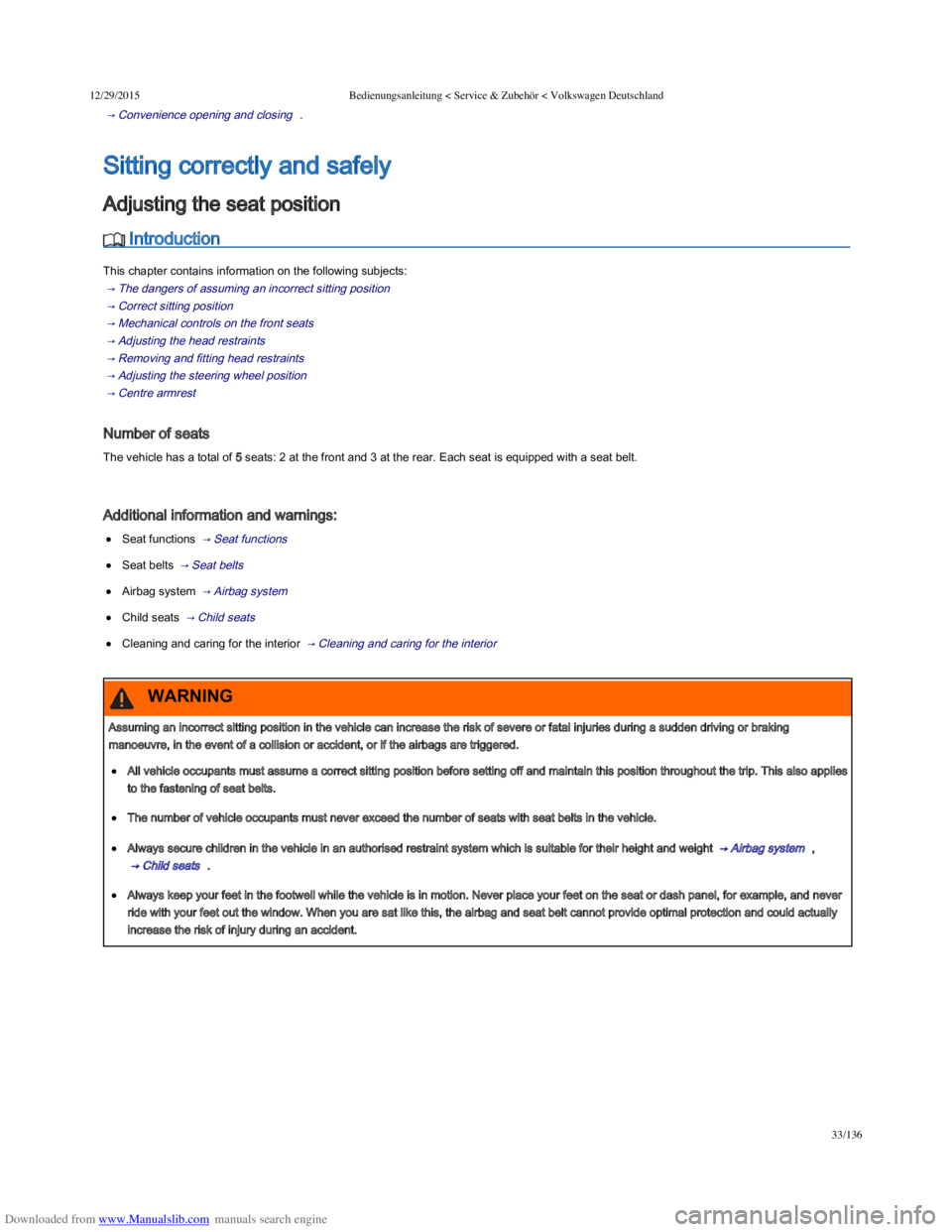
Downloaded from www.Manualslib.com manuals search engine 12/29/2015Bedienungsanleitung < Service & Zubehör < Volkswagen Deutschland
33/136
→ Convenience opening and closing .
Introduction
This chapter contains information on the following subjects:
→ The dangers of assuming an incorrect sitting position
→ Correct sitting position
→ Mechanical controls on the front seats
→ Adjusting the head restraints
→ Removing and fitting head restraints
→ Adjusting the steering wheel position
→ Centre armrest
Number of seats
The vehicle has a total of 5 seats: 2 at the front and 3 at the rear. Each seat is equipped with a seat belt.
Additional information and warnings:
Seat functions → Seat functions
Seat belts → Seat belts
Airbag system → Airbag system
Child seats → Child seats
Cleaning and caring for the interior → Cleaning and caring for the interior
Sitting correctly and safely
Adjusting the seat position
Assuming an incorrect sitting position in the vehicle can increase the risk of severe or fatal injuries during a sudden driving or braking
manoeuvre, in the event of a collision or accident, or if the airbags are triggered.
All vehicle occupants must assume a correct sitting position before setting off and maintain this position throughout the trip. This also applies
to the fastening of seat belts.
The number of vehicle occupants must never exceed the number of seats with seat belts in the vehicle.
Always secure children in the vehicle in an authorised restraint system which is suitable for their height and weight → Airbag system ,
→ Child seats .
Always keep your feet in the footwell while the vehicle is in motion. Never place your feet on the seat or dash panel, for example, and never
ride with your feet out the window. When you are sat like this, the airbag and seat belt cannot provide optimal protection and could actually
increase the risk of injury during an accident.
WARNING
Page 69 of 100
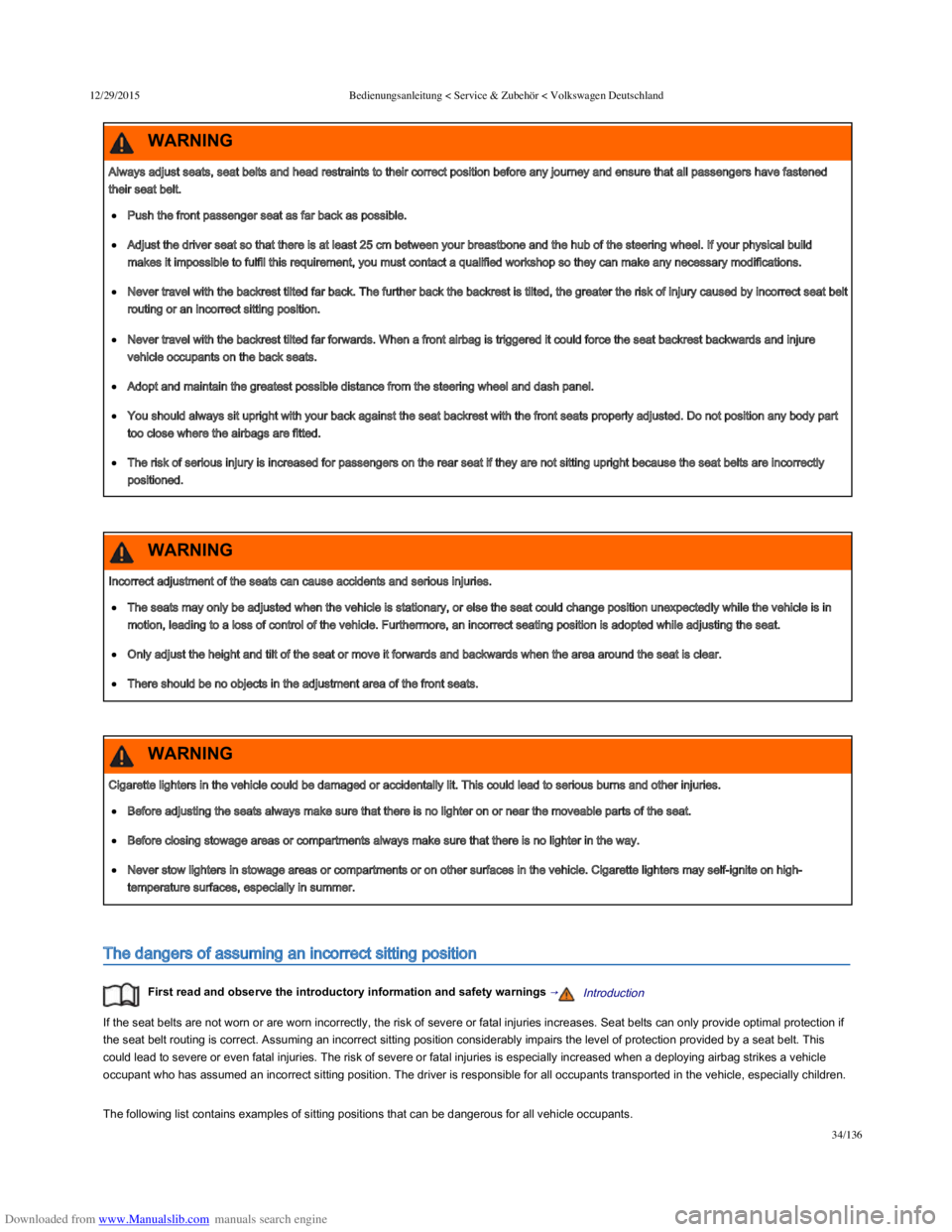
Downloaded from www.Manualslib.com manuals search engine 12/29/2015Bedienungsanleitung < Service & Zubehör < Volkswagen Deutschland
34/136
The dangers of assuming an incorrect sitting position
First read and observe the introductory information and safety warnings →Introduction
If the seat belts are not worn or are worn incorrectly, the risk of severe or fatal injuries increases. Seat belts can only provide optimal protection if
the seat belt routing is correct. Assuming an incorrect sitting position considerably impairs the level of protection provided by a seat belt. This
could lead to severe or even fatal injuries. The risk of severe or fatal injuries is especially increased when a deploying airbag strikes a vehicle
occupant who has assumed an incorrect sitting position. The driver is responsible for all occupants transported in the vehicle, especially children.
The following list contains examples of sitting positions that can be dangerous for all vehicle occupants.
Always adjust seats, seat belts and head restraints to their correct position before any journey and ensure that all passengers have fastened
their seat belt.
Push the front passenger seat as far back as possible.
Adjust the driver seat so that there is at least 25 cm between your breastbone and the hub of the steering wheel. If your physical build
makes it impossible to fulfil this requirement, you must contact a qualified workshop so they can make any necessary modifications.
Never travel with the backrest tilted far back. The further back the backrest is tilted, the greater the risk of injury caused by incorrect seat belt
routing or an incorrect sitting position.
Never travel with the backrest tilted far forwards. When a front airbag is triggered it could force the seat backrest backwards and injure
vehicle occupants on the back seats.
Adopt and maintain the greatest possible distance from the steering wheel and dash panel.
You should always sit upright with your back against the seat backrest with the front seats properly adjusted. Do not position any body part
too close where the airbags are fitted.
The risk of serious injury is increased for passengers on the rear seat if they are not sitting upright because the seat belts are incorrectly
positioned.
WARNING
Incorrect adjustment of the seats can cause accidents and serious injuries.
The seats may only be adjusted when the vehicle is stationary, or else the seat could change position unexpectedly while the vehicle is in
motion, leading to a loss of control of the vehicle. Furthermore, an incorrect seating position is adopted while adjusting the seat.
Only adjust the height and tilt of the seat or move it forwards and backwards when the area around the seat is clear.
There should be no objects in the adjustment area of the front seats.
WARNING
Cigarette lighters in the vehicle could be damaged or accidentally lit. This could lead to serious burns and other injuries.
Before adjusting the seats always make sure that there is no lighter on or near the moveable parts of the seat.
Before closing stowage areas or compartments always make sure that there is no lighter in the way.
Never stow lighters in stowage areas or compartments or on other surfaces in the vehicle. Cigarette lighters may self-ignite on high-
temperature surfaces, especially in summer.
WARNING
Page 70 of 100
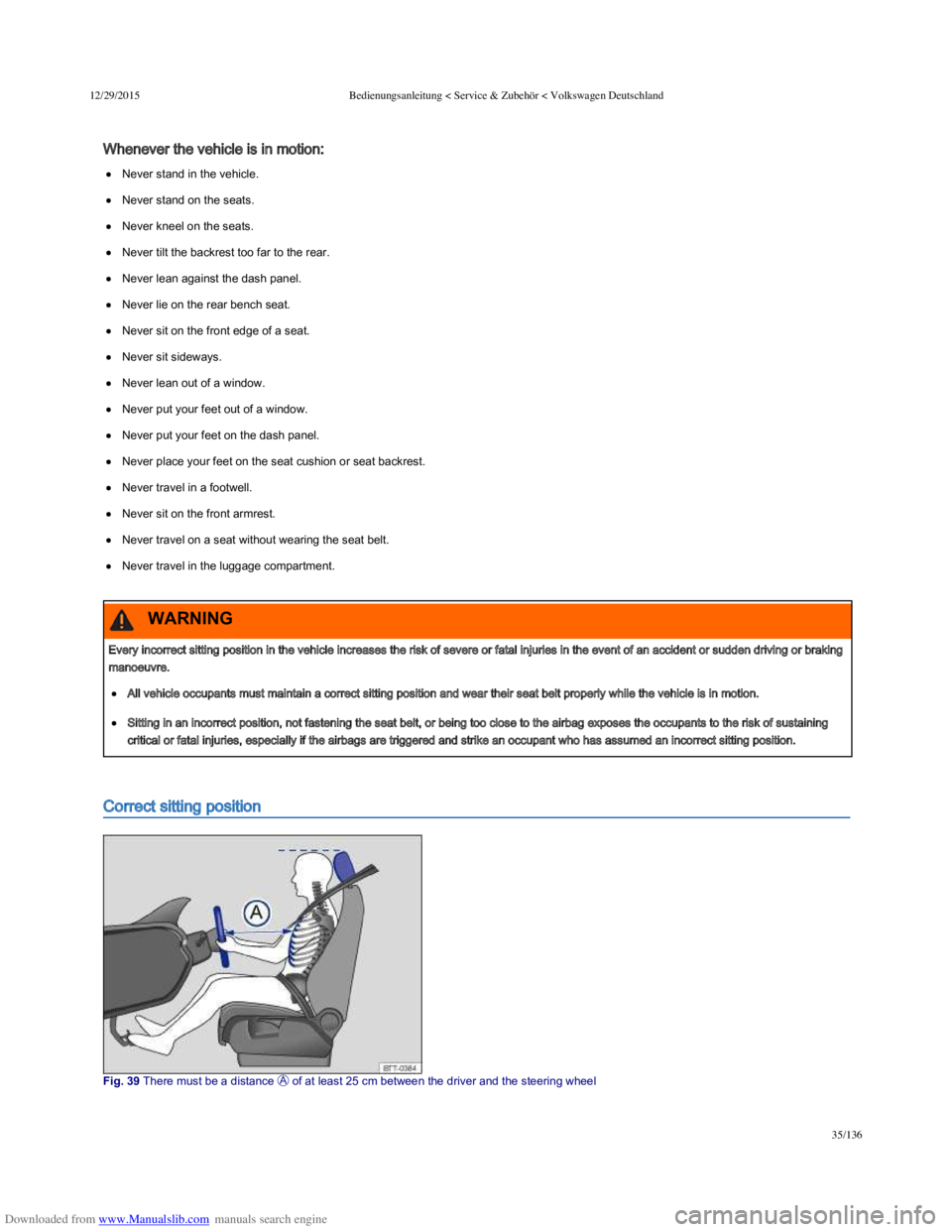
Downloaded from www.Manualslib.com manuals search engine 12/29/2015Bedienungsanleitung < Service & Zubehör < Volkswagen Deutschland
35/136
Whenever the vehicle is in motion:
Never stand in the vehicle.
Never stand on the seats.
Never kneel on the seats.
Never tilt the backrest too far to the rear.
Never lean against the dash panel.
Never lie on the rear bench seat.
Never sit on the front edge of a seat.
Never sit sideways.
Never lean out of a window.
Never put your feet out of a window.
Never put your feet on the dash panel.
Never place your feet on the seat cushion or seat backrest.
Never travel in a footwell.
Never sit on the front armrest.
Never travel on a seat without wearing the seat belt.
Never travel in the luggage compartment.
Correct sitting position
Fig. 39 There must be a distance of at least 25 cm between the driver and the steering wheel
Every incorrect sitting position in the vehicle increases the risk of severe or fatal injuries in the event of an accident or sudden driving or braking
manoeuvre.
All vehicle occupants must maintain a correct sitting position and wear their seat belt properly while the vehicle is in motion.
Sitting in an incorrect position, not fastening the seat belt, or being too close to the airbag exposes the occupants to the risk of sustaining
critical or fatal injuries, especially if the airbags are triggered and strike an occupant who has assumed an incorrect sitting position.
WARNING
Page 71 of 100
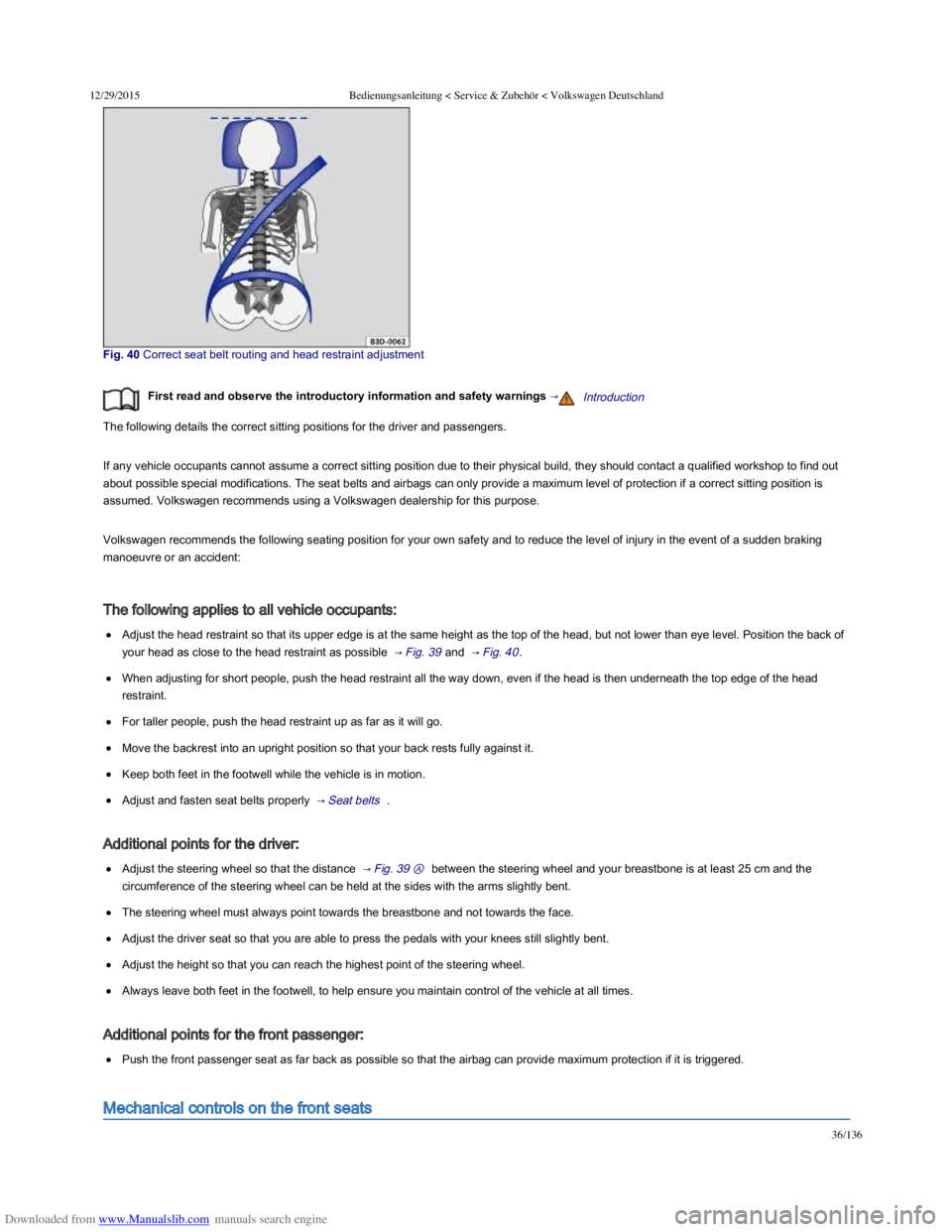
Downloaded from www.Manualslib.com manuals search engine 12/29/2015Bedienungsanleitung < Service & Zubehör < Volkswagen Deutschland
36/136
Fig. 40 Correct seat belt routing and head restraint adjustment
First read and observe the introductory information and safety warnings →Introduction
The following details the correct sitting positions for the driver and passengers.
If any vehicle occupants cannot assume a correct sitting position due to their physical build, they should contact a qualified workshop to find out
about possible special modifications. The seat belts and airbags can only provide a maximum level of protection if a correct sitting position is
assumed. Volkswagen recommends using a Volkswagen dealership for this purpose.
Volkswagen recommends the following seating position for your own safety and to reduce the level of injury in the event of a sudden braking
manoeuvre or an accident:
The following applies to all vehicle occupants:
Adjust the head restraint so that its upper edge is at the same height as the top of the head, but not lower than eye level. Position the back of
your head as close to the head restraint as possible → Fig. 39 and → Fig. 40 .
When adjusting for short people, push the head restraint all the way down, even if the head is then underneath the top edge of the head
restraint.
For taller people, push the head restraint up as far as it will go.
Move the backrest into an upright position so that your back rests fully against it.
Keep both feet in the footwell while the vehicle is in motion.
Adjust and fasten seat belts properly → Seat belts .
Additional points for the driver:
Adjust the steering wheel so that the distance → Fig. 39 Ⓐ between the steering wheel and your breastbone is at least 25 cm and the
circumference of the steering wheel can be held at the sides with the arms slightly bent.
The steering wheel must always point towards the breastbone and not towards the face.
Adjust the driver seat so that you are able to press the pedals with your knees still slightly bent.
Adjust the height so that you can reach the highest point of the steering wheel.
Always leave both feet in the footwell, to help ensure you maintain control of the vehicle at all times.
Additional points for the front passenger:
Push the front passenger seat as far back as possible so that the airbag can provide maximum protection if it is triggered.
Mechanical controls on the front seats
Page 72 of 100
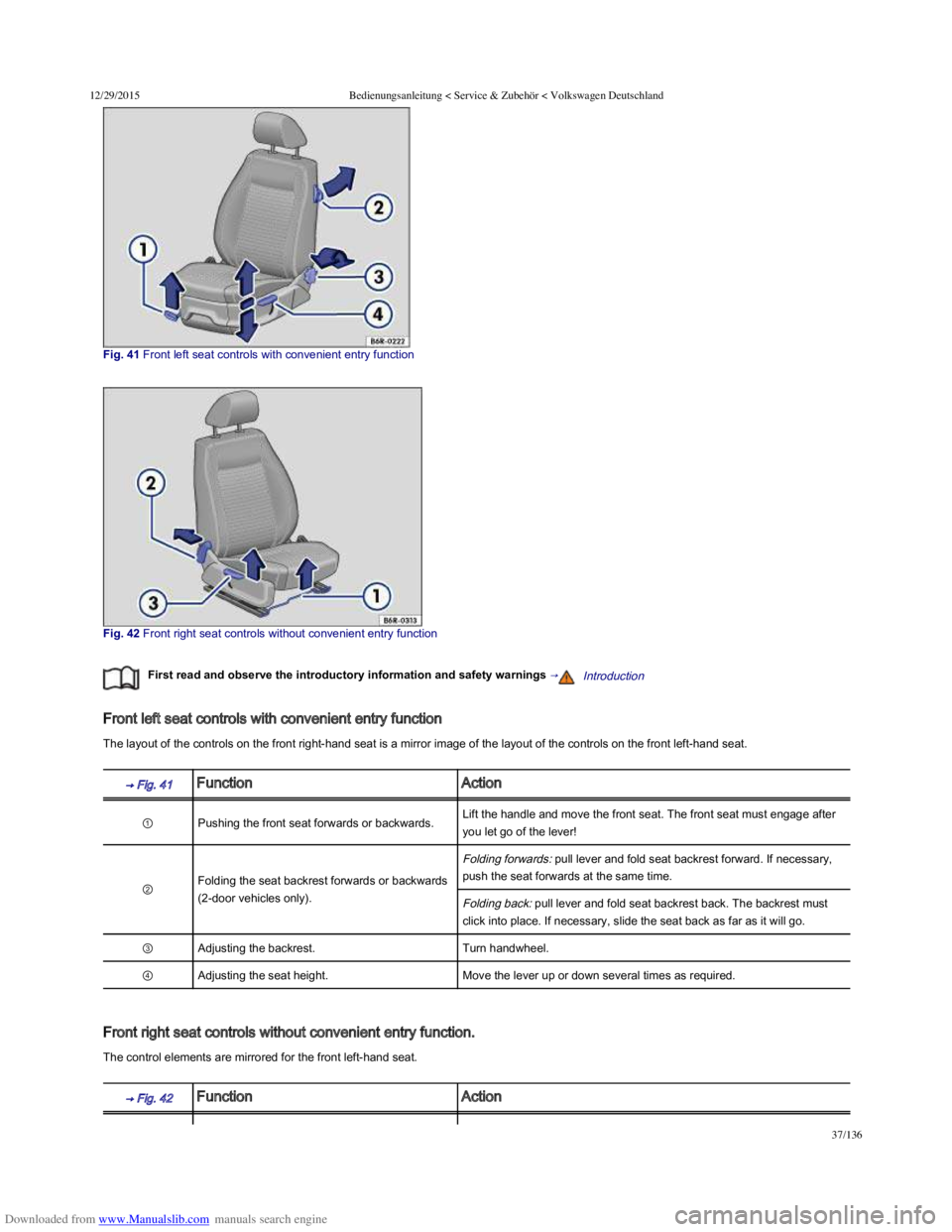
Downloaded from www.Manualslib.com manuals search engine 12/29/2015Bedienungsanleitung < Service & Zubehör < Volkswagen Deutschland
37/136
Fig. 41 Front left seat controls with convenient entry function
Fig. 42 Front right seat controls without convenient entry function
First read and observe the introductory information and safety warnings →Introduction
Front left seat controls with convenient entry function
The layout of the controls on the front right-hand seat is a mirror image of the layout of the controls on the front left-hand seat.
→ Fig. 41 FunctionAction
①Pushing the front seat forwards or backwards.Lift the handle and move the front seat. The front seat must engage after
you let go of the lever!
②Folding the seat backrest forwards or backwards
(2-door vehicles only).
Folding forwards: pull lever and fold seat backrest forward. If necessary,
push the seat forwards at the same time.
Folding back: pull lever and fold seat backrest back. The backrest must
click into place. If necessary, slide the seat back as far as it will go.
③Adjusting the backrest.Turn handwheel.
④Adjusting the seat height.Move the lever up or down several times as required.
Front right seat controls without convenient entry function.
The control elements are mirrored for the front left-hand seat.
→ Fig. 42 FunctionAction
Page 73 of 100

Downloaded from www.Manualslib.com manuals search engine 12/29/2015Bedienungsanleitung < Service & Zubehör < Volkswagen Deutschland
38/136
①Pushing the front seat forwards or backwards.Pull the bar upwards and move the front seat. The front seat must engage
after you let go of the bar!
②Adjusting the backrest.Push the lever back and adjust the backrest. The backrest must engage
after you let go of the lever → !
③Adjusting the seat height.Pull the lever upwards and adjust the seat height using your body weight.
The seat must engage after you let go of the lever!
Adjusting the head restraints
Fig. 43 Adjusting front head restraint
Injuries could be caused if the backrests are folded forwards and backwards carelessly.
Never fold the seat backrest forwards or backwards while the vehicle is in motion.
While folding the seat backrest forwards, always ensure that there are no people, animals or objects in its path.
When folding forwards and backwards, keep all hands, fingers, feet and other body parts away from the seat hinges and seat release
mechanism.
Floor mats or other objects could get caught in the hinges on the seat backrest. The seat backrest might then not engage securely when it is
returned to the upright position.
Passengers (adults and children) must not use seats if the backrest is folded forwards or is not clicked securely into place.
When being folded back, the seat backrest must be securely locked in the upright position. If the seat backrest is not locked properly it could
move suddenly and cause severe injuries.
WARNING
Page 74 of 100

Downloaded from www.Manualslib.com manuals search engine 12/29/2015Bedienungsanleitung < Service & Zubehör < Volkswagen Deutschland
39/136
Fig. 44 Adjusting rear head restraint
First read and observe the introductory information and safety warnings →Introduction
Every seat is fitted with a head restraint. The centre rear head restraint is designed solely for use with the centre rear seat. This head restraint
should therefore not be installed in any of the other positions.
Adjusting the height
Push the head restraint up in the direction of the arrow or push it down with the button pressed → Fig. 43 ① or → Fig. 44 ① → .
The head restraint must click securely into position.
Correct head restraint setting
Adjust the head restraint so that its upper edge is at the same height as the top of the head, but not lower than eye level. Position the back of
your head as close to the head restraint as possible.
Head restraint setting for shorter people
Push the head restraint all the way down, even if the head is then underneath the top edge of the head restraint. There may be a small gap
between the head restraint and backrest in the lowest position.
Head restraint setting for taller people
Push the head restraint up as far as it will go.
Removing and fitting head restraints
Driving without head restraints or with incorrectly adjusted head restraints increases the risk of severe or fatal injuries in the event of an
accident or sudden driving or braking manoeuvre.
If a seat is occupied, the head restraint for that seat must be fitted and adjusted correctly.
Each vehicle occupant must adjust the head restraint to suit their body size, to help reduce the risk of neck injuries in an accident. As far as
possible, the upper edge of the head restraint must be level with the top of the head, but not lower than eye level. Position the back of your
head as close to the head restraint as possible.
Never adjust the head restraint when the vehicle is in motion.
WARNING
Page 75 of 100
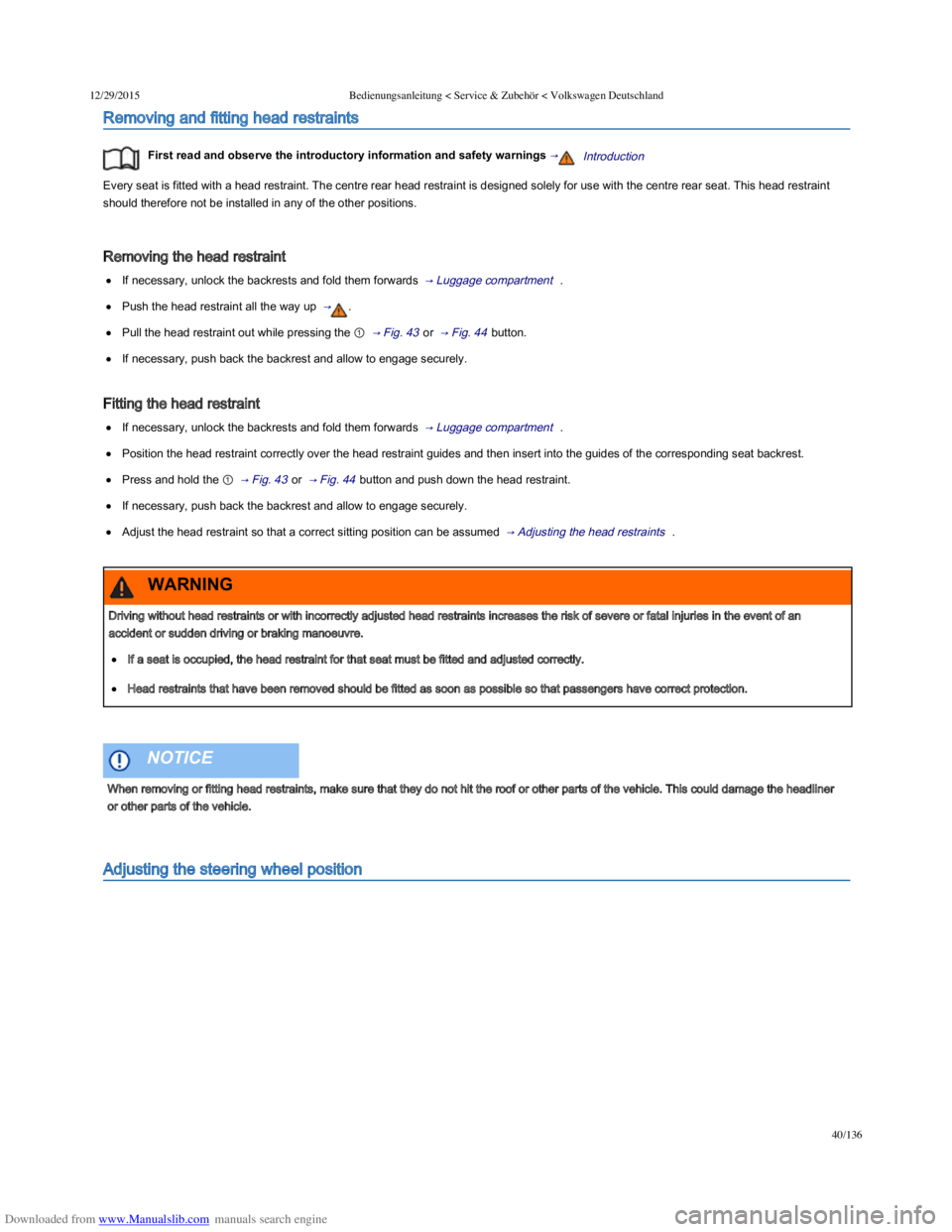
Downloaded from www.Manualslib.com manuals search engine 12/29/2015Bedienungsanleitung < Service & Zubehör < Volkswagen Deutschland
40/136
Removing and fitting head restraints
First read and observe the introductory information and safety warnings →Introduction
Every seat is fitted with a head restraint. The centre rear head restraint is designed solely for use with the centre rear seat. This head restraint
should therefore not be installed in any of the other positions.
Removing the head restraint
If necessary, unlock the backrests and fold them forwards → Luggage compartment .
Push the head restraint all the way up → .
Pull the head restraint out while pressing the ① → Fig. 43 or → Fig. 44 button.
If necessary, push back the backrest and allow to engage securely.
Fitting the head restraint
If necessary, unlock the backrests and fold them forwards → Luggage compartment .
Position the head restraint correctly over the head restraint guides and then insert into the guides of the corresponding seat backrest.
Press and hold the ① → Fig. 43 or → Fig. 44 button and push down the head restraint.
If necessary, push back the backrest and allow to engage securely.
Adjust the head restraint so that a correct sitting position can be assumed → Adjusting the head restraints .
Adjusting the steering wheel position
Driving without head restraints or with incorrectly adjusted head restraints increases the risk of severe or fatal injuries in the event of an
accident or sudden driving or braking manoeuvre.
If a seat is occupied, the head restraint for that seat must be fitted and adjusted correctly.
Head restraints that have been removed should be fitted as soon as possible so that passengers have correct protection.
WARNING
When removing or fitting head restraints, make sure that they do not hit the roof or other parts of the vehicle. This could damage the headliner
or other parts of the vehicle.
NOTICE